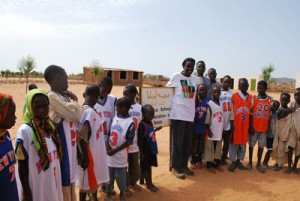
Some of you may have heard of a new campaign called One Million Shirts. They want to collect 1,000,000 used and new t-shirts and send them to Africa to help people with no clothes. They are also collecting money for the shipping costs. They’ve got some NGO partners, and they are starting to think about how best to distribute the t-shirts.
When I first heard of it, I thought it was an another well intentioned mess. The project is taking criticism for obvious reasons (if they’re not obvious, I’ll come back to them at the end of this post). The consistently brilliant Texas in Africa blog vouched for the good intentions of the founder, Jason Sadler, despite the terrible weakness of the idea. I decided I was going to stay out of the argument. Other, smarter people were saying everything I would have.
Then I saw the video. Now I don’t think it’s a well intentioned, poorly planned charity effort. Now I think it’s a marketing ploy from someone who is totally uninterested in helping others. When you actually want your project to have an impact, you listen to criticism. You put your ego aside and learn from what people have to say. You don’t cling to your original idea with wounded fury and attack the people questioning you.
I watched the video seven times, and transcribed it for you. My notes are in red:
****
Hey internet trolls, angry people on twitter, whatever you want to call yourselves.
Angry people on Twitter seems accurate. I don’t know about trolls. Trolls make trouble for the fun of it. Not everyone who disagrees with something is a troll.
You all have a problem with me? That’s fine. I’m very easy to get ahold of. 904 312 2712. Call me.
I am not calling. I am writing this blog post, because I think public discussion is important. And you put your idea out into the world. It seems unreasonable to then demand that all conversation about the idea take place in private. Also, I live in Tajikistan, where I do international development work. Calling you by phone would cost me a fortune, and my internet is too slow for a decent Skype call.
Be a man.
This is sexist. I for one cannot be a man, without major surgery and life changes, because I am female. Are you assuming that everyone who disagrees with you is male? Or that everyone in the world is male? Or, wait – I get where you’re going with this. You think the people who disagree with you are cowardly, and you want them to be straightforward and courageous. Fair enough. But associating bravery and candor exclusively with men is sexist. And yes, your sexism is relevant here. I don’t trust you to do a good job working with women and children if you think they 1) don’t exist or 2) are incapable of courage.
Don’t sit behind Twitter. 140 characters. You don’t even have the time to email me, and you’re going to talk to me on Twitter.
Twitter is a pretty common forum for public discourse. This comment seems roughly equivalent to comparing that someone is hiding behind email or a telephone. I do agree that 140 characters doesn’t lead to useful, detailed discussion. That’s why people are writing blog posts.
I don’t care. I don’t drink hatorade. I really don’t. I don’t care at all. My dog doesn’t care. I don’t care. I don’t care at all.
That is not exactly the response of someone who is interested in learning from criticism. This isn’t personal. Nobody has any problem with you. This is about fear that this project you have founded will hurt the people in Africa that it intends to help. You getting mad does not change that.
If you have a problem with 1 million shirts, you probably really don’t like the fact that I get paid to wear t-shirts for a living. So, go to iwearyourshirt.com if you really want me to ruin your day.
Either this is a massive logical fallacy or a blatant plug for your business. I will assume the best and address it as a logical fallacy. Nobody is opposed to this project because they hate t-shirts or people who wear them. We are worried that sending a big pile of used clothes to African countries will hurt the local textile industry and people who sell retail clothes.
Otherwise I’m going to keep trying to give kids and families who don’t have shirts in Africa clothing to wear. Because you guys all seem to think that everyone in Africa has clothing.
Not everyone in Africa has clothing you would approve of, or want to wear. But yes, I am willing to state that just about everyone in Africa has clothing. Certainly in the countries that you are planning to target: Kenya, Uganda, DRC, Ghana, Liberia, Mozambique, Nigeria, Ethiopia, Sudan, Swaziland, and South Africa. For one thing, Kenya and South Africa are among the strongest economies on the continent.
So apparently you know better than I do. I’ve only been talking to charities who go there often.
Most of the people arguing with you are experienced aid workers and international development professionals with long histories of working with Africa. I am not. I have backstopped Africa programs from DC, and I have a degree in global health, but that’s all I’ve got. J from Tales from the Hood is a different story. So is Texas in Africa. I can pretty much guarantee they have as much or more experience with Africa than the charities you’ve been talking to.
So just want to let you guys know 904 312 2712. I’m happy to talk to anyone who wants to talk like a man maybe step up and actually speak to somebody, not just sit behind a computer. I don’t do that. I step up and get things done. So have a great day, I wish you all the best.
I’m still a woman. Still interested in public discourse, not closed doors wrangling. And I still live in Tajikistan. You have a good day too.
****
For more information on why donations of used clothing can hurt Africans, see the following resources:
1) The T-shirt Travels – a documentary on used t-shirts in Africa
2) Dead White People’s Clothes
3) Oxfam Report on secondhand clothing in Africa
Photo credit: Kim_TD






